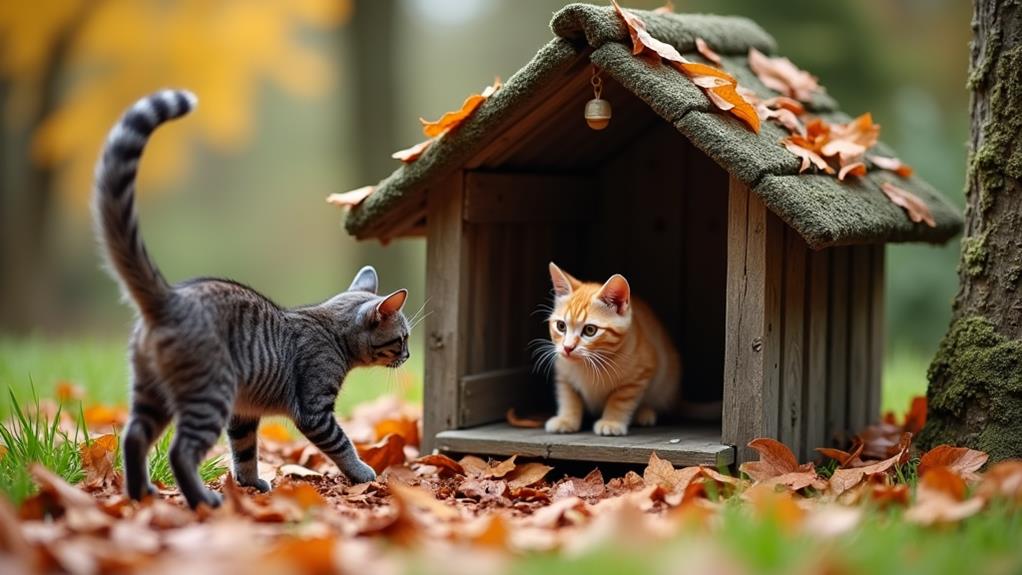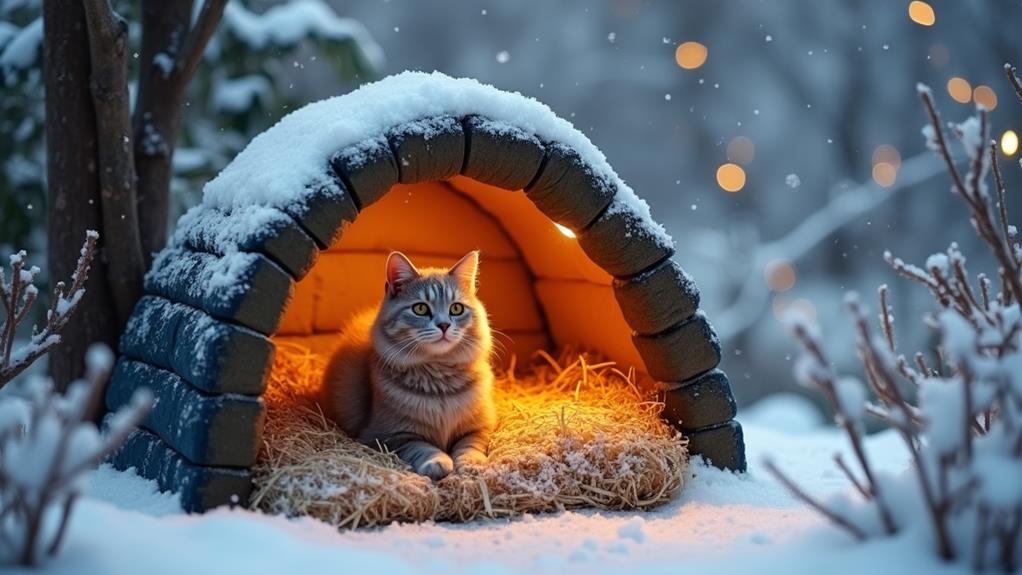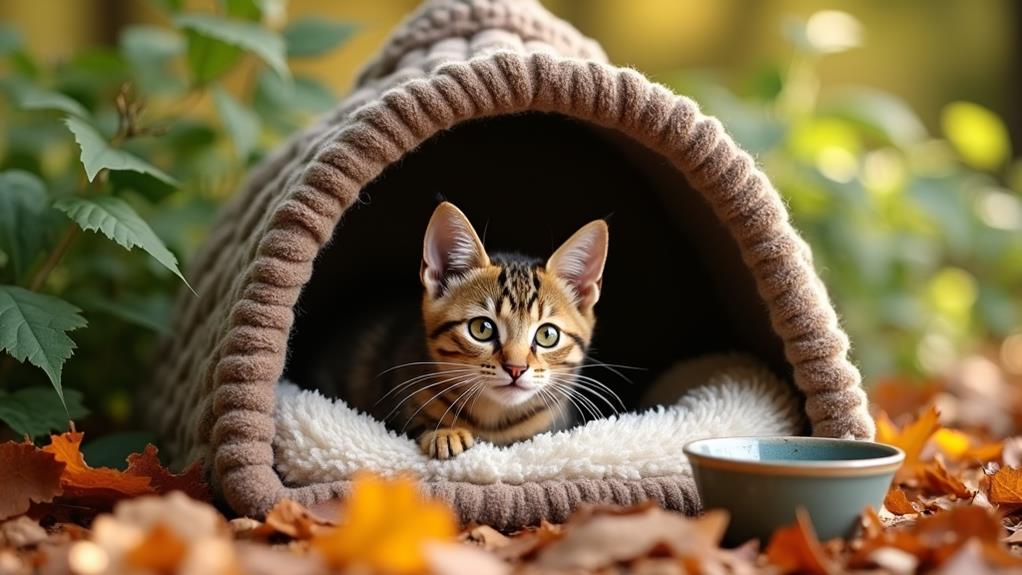How to Get a Feral Cat to Use an Outdoor Shelter: Proven Techniques

To get a feral cat to use an outdoor shelter, start by establishing a consistent feeding schedule near the shelter to build trust. Keep food and water accessible and unfrozen with warmers like K&H Thermo-Kitty Cafés. Secure the shelter in a predator-safe area and raise it with pallets or bricks. Make sure the entrance is small enough to deter larger predators and faces away from harsh winds. Improve warmth using straw and heated pads. Opt for durable, weather-resistant shelters like the K&H Thermo Outdoor Kitty House. There's more to uncover for creating an inviting haven for feral cats.
Entice With Food and Water
One effective way to attract feral cats to an outdoor shelter is by enticing them with food and water. Establishing a regular feeding schedule can notably encourage feral cats to return consistently. By positioning a feeding station near the feral cat shelter, you reduce the distance they need to travel, especially in cold months. This proximity helps skittish cats feel more secure and increases the likelihood they'll use the shelter to stay warm.
It's crucial to keep your food and water in good condition. The K&H Thermo-Kitty Café is a fantastic option, as it's designed to keep food and water warm, making it more appealing in cold temperatures. Likewise, the K&H Thermal-Bowl guarantees water doesn't freeze, even at temperatures as low as -20°F, which promotes hydration. Remember to clear snow away from the feeding station and water bowls to maintain accessibility.
Position Shelter Securely
A critical step in guaranteeing a feral cat uses an outdoor shelter is positioning it securely. You need to place the outdoor cat house in a gated or enclosed area to protect feral kitties from threats like stray dogs and predators. It's significant to raise the shelter 4 to 6 inches off the ground using pallets or bricks. This keeps it insulated from the cold ground and prevents moisture buildup, making it more appealing and safe for cats.
Position the shelter so its entrance faces away from the wind. This small adjustment can make a big difference in shielding the cat shelters from harsh weather. Also, make certain the entrance is small, around 6-8 inches, to deter larger predators. Including two entrances provides an escape route, which is vital for feral cats to feel secure.
To guarantee the shelters blend naturally into their surroundings, use camouflage techniques. Paint them in earth tones and cover them with natural materials like leaves or brush. By taking the time to build and position the shelter thoughtfully, you create a more inviting and secure space for feral cats, increasing the chances they'll use it.
Provide Warmth

After positioning the shelter securely, focus on providing warmth to make it truly inviting for feral cats. Cats are naturally drawn to warmth, especially during colder months, so enhancing the shelter's appeal is essential. Start by integrating proper insulation, such as straw or shredded newspaper, to help trap body heat and keep cold air at bay. Remember, smaller cat houses are more efficient because they allow multiple cats to cuddle together, sharing warmth and maximizing the insulation's effectiveness.
Incorporate a heated pad like the K&H Extreme Weather Heated Kitty Pad for an extra layer of warmth, making your shelter a cozy haven even in harsh conditions. Heated pads are particularly beneficial during Extreme Weather, as they maintain a consistent temperature and offer a comforting spot for the cats to rest. However, make sure that any electric components are safe for outdoor use and regularly inspect them to prevent malfunctions.
Additionally, check the insulation and heated elements periodically to confirm they're functioning correctly, especially after exposure to water or severe weather. By maintaining these features, you provide a reliable refuge for feral cats, encouraging them to return to the shelter in adverse conditions.
Use Durable Shelters
Durability is essential when choosing outdoor shelters for feral cats, guaranteeing they withstand harsh weather and provide a long-lasting refuge. Opt for shelters like the K&H Thermo Outdoor Kitty House, known for their ability to endure severe conditions while offering a safe haven. Designed specifically with durability in mind, these shelters use materials that can handle the elements, making certain feral cats stay protected.
For multiple cats, consider the K&H Thermo Outdoor Multi-Kitty A-Frame. It's crafted to accommodate several cats, providing a warm and secure environment, especially during harsh winter months. Using insulated panels in these shelters improves their durability and warmth, helping to retain heat and protect the cats from extreme temperatures.
Positioning the shelters 4 to 6 inches off the ground prevents moisture buildup and adds an extra layer of insulation against the cold, enhancing the shelter's effectiveness. Regular maintenance is vital—inspect your shelters consistently to confirm they remain sturdy and safe. Address any wear and tear promptly to maintain their integrity. By choosing durable and well-maintained outdoor shelters, you're providing feral cats with the comfort and protection they need against unpredictable weather.
Follow Additional Tips

While selecting durable shelters is a key step, there are supplementary strategies to guarantee feral cats actually use them. To start, position the shelters close to food and water sources. This proximity will attract skittish feral cats and encourage consistent visits. It's vital to make certain the water doesn't freeze in colder months, so consider using heated water bowls to keep it accessible.
Creating a secure environment is also fundamental. Try to find a location with limited access points to deter predators. This will help the cats feel safe and more likely to take refuge in the shelters, especially when the weather gets harsh. Using hay inside the shelters can provide extra warmth and comfort.
If you have a larger feral cat population, setting up multiple shelters can help distribute the cats and reduce competition. This approach guarantees that more cats have access to a safe space. Regularly check and maintain the shelters for safety and comfort, making certain they're clean and free from blockages or hazards. By taking the time to monitor weather conditions, you can ensure the shelters remain effective through extreme temperatures and storms.




